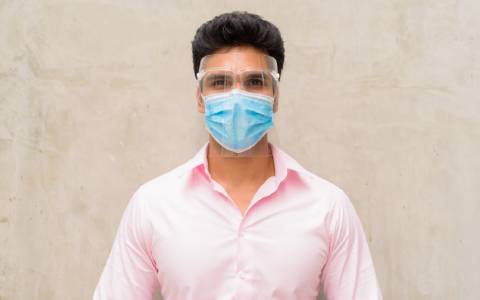
PPE GUIDELINES AND REGULATION
Who determines what is required for PPE and how it is regulated?
Several agencies develop and publish their own set of standards. Some of these are National Fire Protection Association (NFPA), American National Standards Institute (ANSI), The Center for Disease Control (CDC), and the Occupational Safety and Health Administration (OSHA).
What are some examples of how PPE use protects from workplace hazards?
PPE is worn to protect the wearer from contamination against viruses such as COVID-19 or any disease spread through coughing, sneezing, spray, splashes. Additionally, contact transmission can be minimized through hand hygiene, cleaning of surfaces, fresh hand, and body protection.
All types of workplaces pose several risks for injury: fire hazards, sharp blades, forklifts, and heavy machinery, hazardous chemicals, loud noises, falling objects, working at heights, and much more. However, whether the workplace is a laboratory or a factory, essential workers are protected from the present hazards. PPE protects workers from various threats, such as chemical, physical, biological, electrical, mechanical, or radiological. For example, PPE can be earmuffs that prevent permanent hearing damage or a High Visibility vest to alert forklift drivers of other employees’ presence. In addition, there are forms of PPE that can protect employees from falling, protect them from burning, and even from damaging their corneas.
FACIAL AND EYE PROTECTION
What are the different levels associated with masks?
There are three levels of mask protection, as determined by the American Society for Testing and Materials.
- Level 1: has the least fluid resistance to bacterial and particulate filtration and breathing resistance. These masks are appropriate for circumstances where there are lower amounts of fluid and aerosol spray. An example would be patient evaluations, orthodontic visits, or operatory cleaning.
- Level 2: has moderate fluid resistance to bacterial and particulate filtration and breathing resistance. These are appropriate for procedures producing moderate to moderate amounts of liquid, spray, or aerosols. Some examples: sealant placement, simple restorative or composite procedures, or endodontics.
- Level 3: has the maximum level of fluid resistance recognized by ASTM and is designed for practices with moderate or heavy amounts of blood, fluid spray, or aerosol exposure. Some examples: crown or bridge preparations, complex oral surgery, implant placement, or use of ultrasonic scalers.
How should disposable masks be used?
The guidance by the CDC for single-use, disposable facemasks has not changed. Disposable masks are tested and regulated by FDA to be single-use. Masks need to be changed between patients or during patient treatment if it becomes wet.
What is a respirator, and how does it work?
A respirator is a personal protective device designed worn on the face or head. The nose and mouth need to be covered. CDC/NIOSH certifies respirators, including those intended for use in healthcare settings, and should be fit tested before use.
How does an N95 respirator work?
An N95 filtering facepiece respirator (FFR) is a respirator that removes particles from the air breathed through it. These respirators filter out at least 95% of tiny (0.3 microns) particles, including bacteria and viruses.
Can facial protection prevent the transmission of viruses such as COVID-19?
Personal protective equipment (PPE) is necessary to prevent infections from spreading. Respirators alone do not protect against coronavirus.
Are face shields equal to goggles in terms of eye protection?
It depends on the environment and situation. Goggles cover the entire eye, protecting it from splashes, sprays, and droplets. However, a face shield provides similar protection, but not the same. Can face shields be cleaned and reused?
Face shields should be cleaned after visiting different patient rooms in a medical setting, disposed of at the end of the day. They should not be cleaned then reused by others, or even used another day.
BODY AND HAND PROTECTION
Can surgical gowns be used as isolation gowns if necessary?
Surgical gowns and isolation gowns have different intended use claims. However, if necessary, a surgical gown can be used as an isolation gown, but an isolation gown cannot be used as a surgical gown.
How do I know what gloves are best for my organization or needs?
Our Medical Glove Buyer’s Guide will be beneficial in answering your questions. However, if you still have others, feel free to contact our sales team at (866) 690-6793 or info@awdinc.net

USE, STORAGE AND DISPOSAL OF PPE
Can PPE be shared, reused, or altered?
Most forms of PPE are designed exclusively for one-time use, such as disposable earplugs, disposable respirators, latex gloves, and shoe covers. Because there is no proper or recommended way to clean and disinfect disposable PPE, it is essential for these items not to be used more than once as it could pose an even more hazardous risk. Employees should be informed that immediately after using these items, they should be appropriately disposed of. For some workplaces, like hospitals, some gowns are meant to be washed, disinfected, and used again. In some instances, PPE products, such as washable and reusable gowns, can be shared as long as proper cleaning and sanitization protocols have been followed. In other cases, items such as disposable masks, should not be shared with others.
What is the correct and proper way to dispose of used PPE items?
Personal protection equipment, or PPE, is an essential element for any facility’s safety program’s success. There are different PPE types, including gloves, gowns, masks, face shields, earplugs, eye protection,
hardhat, and full-body hazmat. PPE, in some instances, can be reused without issue. In other uses, it will be just one-time use. No matter what type it is, all PPE will eventually need to be disposed of, and it is vital to ensure that it is done correctly.
Gloves can be disposed of by simply turning them inside out while removing them. Disposable gowns can also be disposed of this way. Surgical gloves, which contain blood, or PPE exposed to susceptible conditions such as caring for a COVID patient, may require other disposal protocols consistent with biohazard materials. Other PPE, such as respirators, require destruction so that they can’t be confiscated from the trash and reused or salvaged. OSHA has specific instructions, and they may be in addition to CDC guidelines as to how to dispose of PPE items. Safety managers have a responsibility to keep up-to-date with the correct protocols.
What is the correct way to store PPE?
Each facility should have a specific area, away from harsh conditions, designated solely for storing PPE. How PPE is stored depends on the product. Some PPE items have expiration dates (e.g., gloves) which can become brittle and prone to puncture as they age. Other things, such as washable, reusable gowns, can have a fluctuating shelf life, largely contingent on the frequency of use and the cleaning process. Other factors, such as temperature, humidity, the potential for contamination, etc., impact the shelf-life. Each product should have the label carefully reviewed to ensure correct storage and protocols for care.

AWD PPE PRODUCTS
Do you sell PPE products that have expired?
We only recommend products that conform to the product labeling and will not sell an expired product.
Do you sell products manufactured in the USA? If yes, how can I identify them?
Absolutely! Our “Made in the USA” products proudly feature an icon stating that they are manufactured in the United States, and the details of the products also indicate that they are made in the USA. How can I see the product specification sheets and other details about PPE products?
Generally speaking, all products contain details within our website and may also include data sheets as well. If, however, you require more information, our sales team would be happy to assist you. Contact our sales team at (866) 690-6793 or info@awdinc.net.
